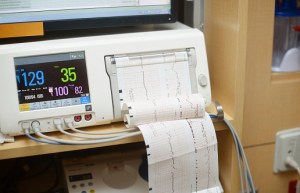 During the labor and delivery process, unborn babies should be consistently observed through electronic fetal monitoring and visual monitoring of the mother. Through diligent and proper observation, doctors and nurses can recognize signs of fetal distress, an umbrella term for issues that may cause your baby’s health to be in danger. Prompt and effective treatment can often reverse the effects of distress.
During the labor and delivery process, unborn babies should be consistently observed through electronic fetal monitoring and visual monitoring of the mother. Through diligent and proper observation, doctors and nurses can recognize signs of fetal distress, an umbrella term for issues that may cause your baby’s health to be in danger. Prompt and effective treatment can often reverse the effects of distress.
Mothers with preexisting conditions and/or high-risk pregnancies will be monitored extra carefully, but all fetuses and mothers should be watched closely for complications.
Signs of fetal distress
Typically, during labor and delivery, the major sign of distress is an abnormal heart rate. Your infant’s heart rate should be between 110 and 160 beats per minute (BPM) during labor, according to Johns Hopkins Medicine Health Library. During contractions, it is normal for the baby’s heart rate to slow for a bit, but then go back to normal when the uterus relaxes. These early decelerations in heart rate are not usually concerning.
If the heart rate falls below 100 BPM for a period of time, this could be a sign of real distress, according to the American Journal of Obstetrics and Gynecology. A rapid heart rate of more than 160 BPM for more than 10 minutes can be concerning as well. An abnormal heart rate could be caused by:
- Prolapsed umbilical cord
- Umbilical cord being wrapped around the baby’s head
- Shoulder dystocia
- Post-term pregnancies
- Multiple births
- Conditions that were present during pregnancy
Low fetal oxygen levels, prolonged labor, and signs of umbilical cord problems could be additional indicators of fetal distress.
Responding to fetal distress
A doctor may respond to these emergencies in a variety of ways, depending on the specific problem and depending on what phase of the labor and delivery process the patient is in. For instance, shoulder dystocia could be corrected by performing an episiotomy.
Other examples of how to respond to fetal distress include:
- Changing the mother’s position
- IV hydration
- Reducing Pitocin
- Alleviating umbilical cord compression
- Giving oxygen
Some situations call for an emergency C-section. A well-trained and experienced doctor should know what corrective measures to take. If fetal distress is not responded to properly, a baby could sustain a severe birth injury.
Families who suspect their OB/GYN did not give the appropriate care during labor and delivery can call the law firm of Plaxen & Alder, P.A. We help parents obtain justice when an act of negligence causes harm to you or your baby. To speak with a seasoned Maryland birth injury lawyer today, call 410.988.4449 or fill out our contact form.





